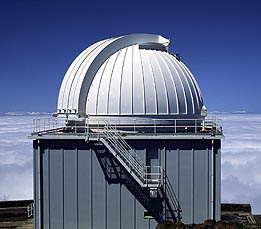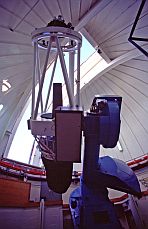 | |||
|
| Home > Astronomy > Jacobus Kapteyn Telescope |
 | |||
|
| Home > Astronomy > Jacobus Kapteyn Telescope |
Jacobus Kapteyn Telescope 
This is the old JKT home page, retained for historical interest. The JKT was in use by the ING observing community from 1984 until July 2003. Over the next decade, it remained part of ING, and was in occasional use for various projects (e.g. SCIDAR characterisation of atmospheric turbulence above the observatory). As of 15 Jan 2014 the JKT is owned by the Instituto de Astrofísica de Canarias (IAC), and is operated by the Southeastern Association for Research in Astronomy (SARA) under agreement with IAC. The JKT resumed operations as a robotic telescope in October 2015. More information can be found in an IAC press release and this paper. IntroductionThe Jacobus Kapteyn Telescope (JKT) has a parabolic primary mirror of diameter 1.0 m, and two interchangeable secondary mirrors. The telescope is usually fitted with the hyperboloid secondary mirror, which gives a conventional f/15 Cassegrain focus. The alternative f/8.06 Harmer-Wynne system uses a spherical secondary and a doublet corrector to give a field of 90 arcmin diameter for photographic astrometry over a wide field. The JKT is equatorially mounted, on a cross-axis mount, which allows operation east or west of the pier. Normally it is east of the pier. The observing limits are currently:
A more detailed description of the optics and the mounting of the JKT is available in the Observers' Guide. For more information about the Telescope Control System please see the JKT TCS manual. For other documents see the manuals for JKT instruments. For more information about the JKT, see the public information web pages. InstrumentsObservingAn ALPHA station lpas1 runs the telescope control system. Computer lpss10 hosts the observing system, i.e. data acqusition (UltraDAS), instrument control (ICS) and data inspection (IRAF). NB at ZD >~ 45 degrees in the west, the tracking is poor. Jumps in tracking typically manifest themselves as double images on the CCD. Observers should therefore plan their observations to aovoid HA > 3 hours. Quality ControlCoordinates of the JKT
| ||||||||
| Top | Back |
|